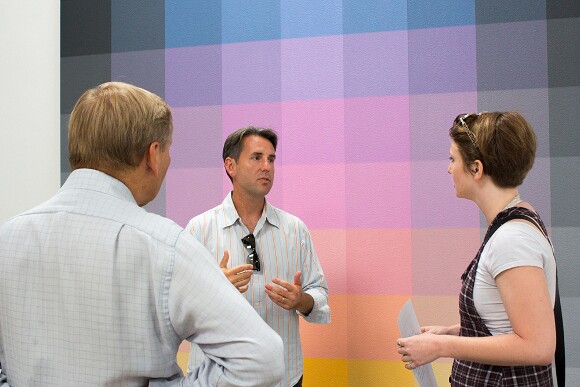Scents Memory: Brian Goeltzenleuchter's Multifaceted Practice

Artist Brian Goeltzenleuchter is inclined to pose questions -- to himself and to others. It's as if he is something of a Socratic style thinker in the guise as an artist.
Here is one of those recent, self-directed questions -- "What is smell's relationship to narrative?" He voices it to me during a visit to his studio, which has a loose resemblance to a lab, with its expanse of small tubes containing differently colored liquids spread across a table.
That question about scent and storytelling yielded a grant proposal, which in turn led to a Creative Catalyst grant from the San Diego Foundation earlier this year. Goeltzenleuchter was one of 10 artists from a spectrum of disciplines who were awarded $20,000 in this third year of the program.

One of the requirements of the grant program is to team with a local non-profit organization and Goeltzenleuchter has made a virtue of collaboration with his conceptually based work. For "Olfactory Memoirs" -- the title of this project in progress -- he has joined with a local writing organization (San Diego Writers Ink) and one of its highly experienced instructors, Judy Reeves, to conduct workshops in which participants delve into childhood memories that use the recollection of a scent as a catalyst.
Ultimately, the process will yield a reading by a few of these writers, in which their prose will be accompanied by an ingeniously engineered release of scents.
"We'll pump in a smell to a room in such a way that it can be pumped right back out," the artist explains.

Goeltzenleuchter has had help from artist Dave Ghilarducci in the engineering process, but downplays a final event for now -- there won't be a full-blown performance until 2017. There will be a kind of staging to fulfill the conditions of the Creative Catalyst grant, but he's more inspired by the process that is taking place than the final product.
His work with scent reaches back to 1998 -- he would earn an MFA in art from UC San Diego in 2001 -- though he's focused on it more fully for the past eight years. His focus with the scent projects has been national and beyond. He's currently working on a new work for an exhibition at the Poetry Foundation in Chicago at the moment.
He clearly likes being part of the "smell community," as he terms it, which, as he reminds me, is international in scope. He cites one of his favorite writers and theorists on the relationship of smell to environment as an inspiration. She is Victoria Henshaw, a lecturer in urban planning and design at the University of Sheffield in the UK. And the London-based publisher, Routledge, has asked him to contribute a chapter to a book on olfactory art and design about, in his phrase, "adapting smells to museums. "

Most recently, Goeltzenleuchter completed a project for the exhibition at the San Diego Art Institute "San Diego Keeps Her Promise: Balboa Park at 100." He queried six individuals about their memories of the park and made a scent in relation to each. You could take in that scent and then take a self-guided tour related to it. One example: the lovely lily pond that adjoins the Timken Museum of Art.
Still, it would be a mistake to call Goeltzenleuchter a scent artist. His work in that arena has been part of a broader intention to blur the boundary between art and commercial culture, between art and the self-help industry.
His barbed wit and a sardonic use of irony come to the fore with other projects. There is "The Art Courage Program," created by the artist and writer Katharine Whitcomb. It's a book and audio program. Its subtitle: "A Therapeutic Plan to Free You from Your Fear of Art."
Both the artist and Whitcomb have a good ear for the "soothing" style of therapeutic prose. The book promises, in its introduction, "I'll show those of you who've been suffering with art anxiety how to move, step by step, through and beyond its darkness." There are questionnaires, mantras and even a three-point plan designed to help anyone overcome their fear or hostility to contemporary art. It's the best straight-faced, tongue-in-cheek publication on the divide between popular and "highbrow" views of contemporary art since "Painting by Numbers: Komar and Melamid's Scientific Guide to Art" in 1998.
The book, with its fractured mirror of the self-help mindset, is part of a wider net of cultural arenas that the artist subsumes into his work. On the book cover for "The Art Courage Program," it says: "Brian Goeltzenleuchter of Contraposto Living." Go to its website, and you'll find other a straight-faced parody of a kind of lifestyle site, which includes domestic items like candles (these are art themed icons like the "Venus of Willendorf") and advisory services for personal and institutional well-being. And of course you can purchase the limited edition of "The Art Courage Program" there, which includes "therapeutic fragrances" for different art occasions to relieve anxiety.
Given his broad interests, perhaps it's fitting that Goeltzenleuchter is currently teaching at the School of Public and Urban Affairs at San Diego State University rather than in the art department. As part of a fellowship, he's teamed with criminologist Paul Kaplan there, as well as technologist Dan Salmonsen, to create a website called The Art|Crime Archive and is offering a course called "The Cultural Lives of Art and Crime." Topics on the site include Chicano Park, the "Canadian Response to Graffiti" and "Who Profits from Murder?"
"The archive has had more visibility in criminology circles than the art world," observes Goeltzenleuchter.
And he clearly enjoys the irony of such recognition.





Dig this story? Sign up for our newsletter to get unique arts & culture stories and videos from across Southern California in your inbox. Also, follow Artbound on Facebook, Twitter, and Youtube.


